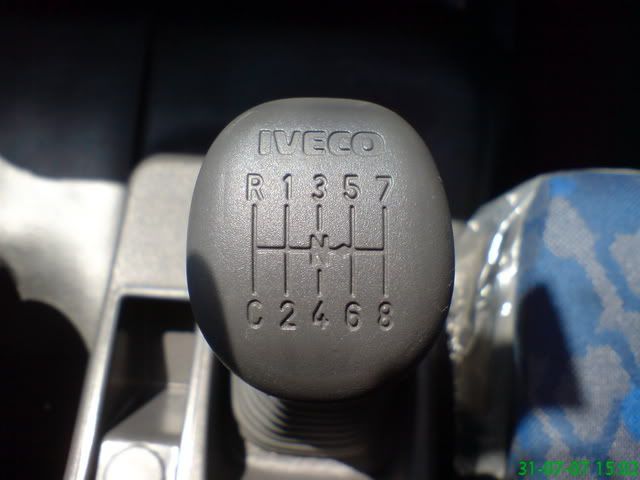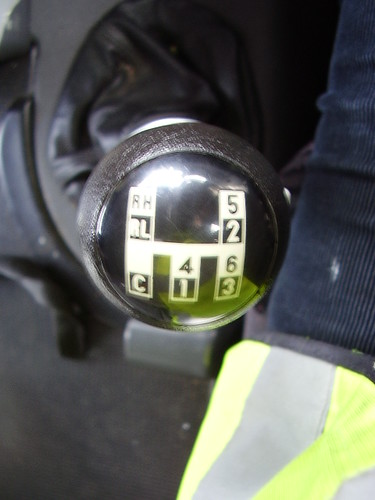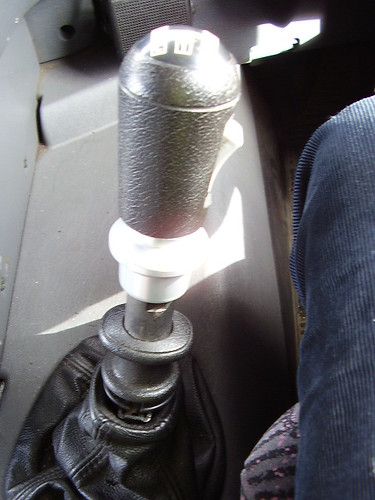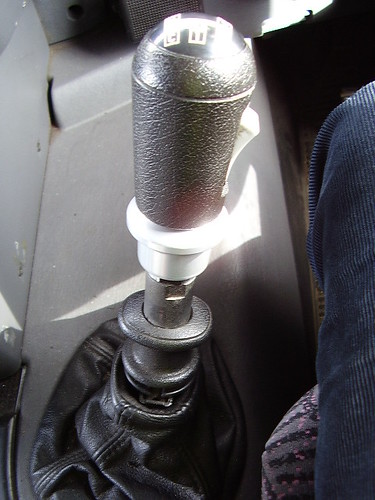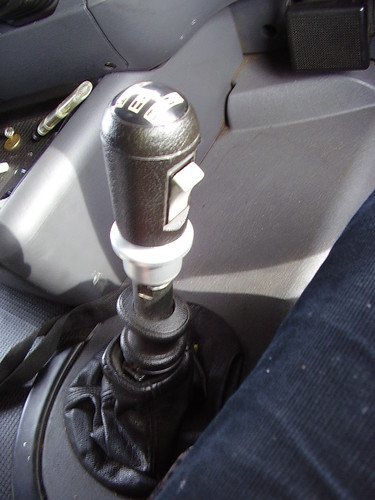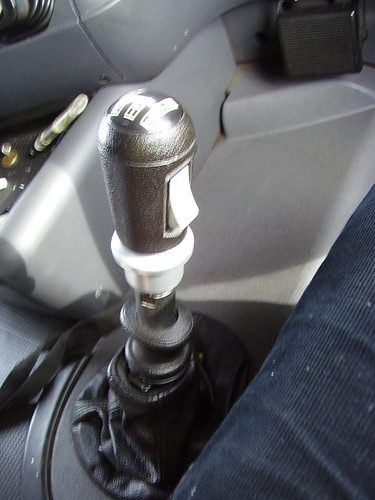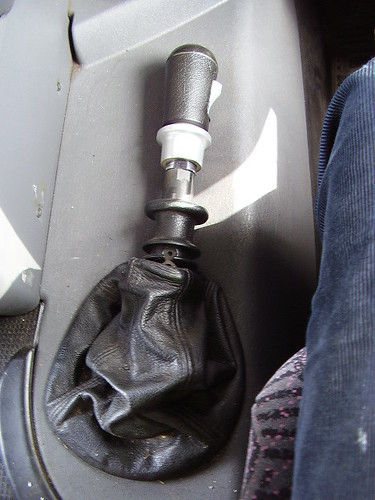This post is designed to be an introduction to the coupling exercise and is written in a deliberately non-technical way. It relates to C+E artics.
I’m aiming at giving you a head-start with terminology and some pics of the items.
There’s no attempt at describing the exact procedure, because ROG has covered that in the next post below this. 
(It’s a l..o..n..g post, so grab a butty and you’ll need to scroll…  )
)
The tractor unit in the pics is an “S” registered Volvo FL10 as used by many LGV training schools.
The pic below is of a fairly common type of fifth-wheel known as a “slider.”
The non-sliding type wouldn’t have the shorter of the two handles, because that kind of fifth-wheel is “fixed.”
I’m not covering the sliding of it, because it might cause confusion.
The one thing I’ll say about sliding these is that it should only be carried out by an “old hand,” because if you get it wrong, the potential damage could be very expensive to put right.
PIC 1

The big greasy plate is the “fifth-wheel” (this one needs more grease!!) The fifth-wheel supports the weight of the front end of the trailer and has a locking mechanism for grabbing the trailer’s “king-pin” just visible at the bottom of the “V” shaped notch in the above pic. To uncouple the trailer you stand on the driver’s side of the truck and, after removing the safety-clip, pull the longer of the two handles towards you. After the landing legs have been lowered, the action of pulling out the handle about 2’ (like in the pic) “opens” the coupling and you can then drop-off the trailer.
PIC 2

You can see the locking mechanism much more clearly in this pic.
The locking mechanism grabs the trailer’s “king-pin.”
The king-pin is in the centre of the pic below.
PIC 3
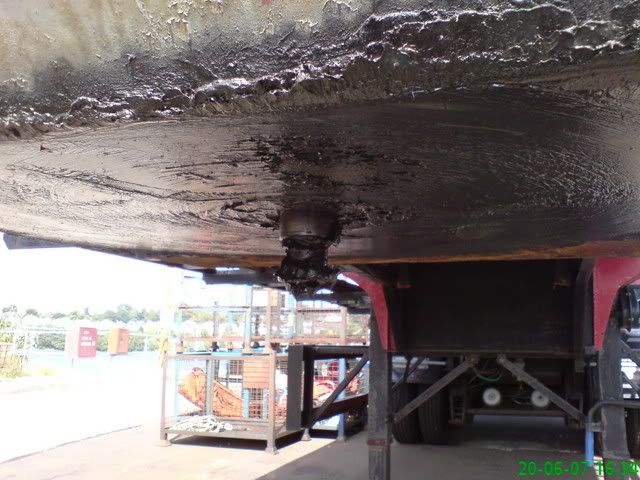
It’s very important to make sure that the heights of the fifth-wheel and kingpin are correct, because if the trailer was dropped-off by a higher tractor unit you’d miss the pin completely and smash the back of your cab with the front of the trailer. (It has been known to happen…  ) When you’ve checked the heights (from outside the cab,) you reverse gently under the trailer until you hear a clunk. You then do a couple of “test-pulls” to make sure that you have “grabbed” the king-pin correctly. If you look at it again from outside the cab, you’ll notice that the lock release handle (the longer of the two in the first pic,) is now much shorter, because the coupling has closed AND locked. That’s what makes the (loud) clunk noise. We can say that the closing and locking of the coupling is automatic, once you’ve reversed far enough.
) When you’ve checked the heights (from outside the cab,) you reverse gently under the trailer until you hear a clunk. You then do a couple of “test-pulls” to make sure that you have “grabbed” the king-pin correctly. If you look at it again from outside the cab, you’ll notice that the lock release handle (the longer of the two in the first pic,) is now much shorter, because the coupling has closed AND locked. That’s what makes the (loud) clunk noise. We can say that the closing and locking of the coupling is automatic, once you’ve reversed far enough.
That just leaves the air and electrical “susies” so here’s a few pics of those.
They don’t need much explanation, because they have different ends/connectors, so you can’t really make any mistakes with these.
I’ll just stick with what we call them.
PIC 4
Red air line.

PIC 5
Yellow air line.

PIC 6
3 x Electric “susies” (Various sized/coloured ends with different connectors.)

Your instructor will give you as much detail and explanations as you you’ll need for your test.
I avoided trying to describe the exact procedure so as to leave you with a head start rather than a spinning head.
I hope there’s a bit less mystery to the words we use and what the things look like. Like my post about the gearboxes, could you please leave a bit of feedback so I know whether I’ve got this right- CHEERS.
I hope you find it helpful. 
GOOD LUCK with the driving tests.!!!
Full credits to dieseldave for the above.
===================================================================================
ARTIC UN/COUPLE PROCEDURE for the DSA test.
NOTE: The coupling/uncoupling procedure is 33 seconds into the video.
There are a few more un/couple videos on youtube = m.youtube.com/watch?v=TeVzwQ4o1B0
Included are references to the pics in Dieseldave’s post above 
The usual time to do this is after the road drive and on the reversing area — the examiner will inform you where to park and you will stop in a straight line. A lot [of test candidates] ask the examiner if whether they have passed at this point because they feel that doing the un-couple & couple-up procedure is just wasting time if they have already failed — this is acceptable to the examiner.
Not every instructor teaches this exactly the same way but there will not be much difference. For ease, I have divided this into three stages. 1, the uncouple, 2, the trailer check and 3, the couple up. I always get my trainees to do a complete circuit of the lorry.
Stage one — the uncouple.
Switch off engine and exit cab with the keys and some gloves.
The word is B.L.A.C.K.
B = brake
L = legs
A = airlines (and electrics)
C = clip
K = kingpin (coupling locking device)
Mothertrucker:
Good one - although I always use BLANK
Brake
Legs
Airlines
Number plate
Kingpin (which includes clip)
Apply trailer (B)rake. There are usually two pull devices and only one is the brake — the other is the shunt. Your instructor will show you, which is which as not all are set up the same or located in the same place on each trailer.
Wind down the (L)egs until the lowest leg touches the floor and then do one wind back with the handle and stow it in the holder. This prevents a big BANG as you pull the unit out and on the couple up, if the unit is not perfectly lined up with the trailer, it lets the trailer “float” so the legs do not gouge the floor — the DSA do not like their reverse area having chunks of tarmac missing!
There are two aspects to the winding handle set up, the spigot and the handle. The spigot has 3 settings. Pulled fully out for normal windup & down, pushed fully in for super slow wind up & down and the middle of the two, which does nothing. The winding handle is used to pull or push the spigot. So, for normal winding down of the legs, pull the spigot fully out with the handle and then gently slide the handle back in along the spigot without pushing the spigot back in — this will now allow you to wind down the legs with one hand as the handle is locked along the spigot.
Now the (A)irlines & electric connections need to be detached from the trailer and properly stowed onto the holders on the back of the unit. On my set up there are 2 airlines and 3 electric ones. The red airline (see pic 4) is detached by turning the collar until the groove in it lines up with the little spigot, then pull the collar so the groove slots into the spigot and the red line will now release. The yellow airline (see pic 5) also has a collar and a groove, which will line up with a spigot, but this time the collar is pushed into the spigot to release it.
Two of the electric lines just pull out but the ABS electric line has a ‘trigger’ to pull underneath it (see pic 6) so it can release — this ‘trigger’ needs to be pushed forward to connect it properly onto the housing for it on the back of the unit.
Most units have steps to get up onto the back of the unit — use them and get down the same way — do not jump off — it’s very hard to carry on with a twisted ankle or worse!
At this point, all the work has been done on the nearside of the set up I use, so I now get the trainee to walk around the back of the trailer to get to the clip. Whilst passing the rear, they say, “remove number plate” to the examiner.
The (C)lip is a safety device that stops the kingpin handle from being pulled out. This is the bit where you usually get muck & grease etc on you!
Reach under the body of the trailer, above the rear unit axle and squeeze the lower part of the clip so that the top bit can be pushed up and out of the hole that it is slotted into. If you have a place to stow the clip, which is usually on a chain attached to the unit, then do so — it makes it easier to find on the couple up.
The (K)ingpin handle is now ready to be pulled out and is done by pulling it slightly forward and then fully out (two hands if struggling) with a slight back pull to lock it out. Do not mix up the kingpin handle with the plate slider handle (see pic 1) if your set up has one — your instructor will show you which is which.
Get back into the cab and engage a low gear to pull the unit from under the trailer, taking care not to drop the trailer the last inch, due to the legs not quite touching the floor, when the fifth wheel plate tilts up from the front of the trailer body.
Park the unit parallel to the side of the trailer, facing forward — the examiner might tell you which side to put it.
Stage two — the trailer check.
The examiner will ask you to pick up the trailer and to pretend that you have never seen this trailer before.
Get out of cab with keys and gloves.
Do a complete trailer check, just like the one you did before setting out in the morning, body, reflectors, doors, tyres, nuts etc, etc, with the addition of the fifth wheel pin check (see pic 3) as they may be a pin lock on it or something might be wrapped around it . Is the trailer MOT in date? Are the connectors for the air and electric lines damaged? On the walk around trailer check, tell the examiner what you are looking at, or touch (hence the gloves) all the areas that you are checking. That way, the examiner can see what you have checked.
MAKE SURE THE EXAMINER SEES YOU CHECK THE TRAILER BRAKE IS ON BY GIVING THE BUTTON A PULL.
Now, get back into the unit and whilst going forward in front of the trailer line up using both mirrors. Reverse towards the front of the trailer using both mirrors to line it up ( you should be able to see the same amount of trailer in each mirror as you do so ) and stop as close as possible without going underneath. Leaving the engine running (seems to be the accepted practice at this point as it is only going to be for a moment) get out of the cab and check that the fifth wheel plate will go just under the trailer (I get my trainees to do this with a flat hand, palm down gesture) and then lightly touch the fifth wheel handle to show that you know it is still out (has been known for some to spring back in!), then get back into the cab and proceed to reverse under the trailer.
You will feel and hear the locking of the unit to the trailer but to check that it is locked, engage a low forward gear and gently try TWICE to pull out.
Apply handbrake.
Stage three — the couple up.
Get out of cab with keys and gloves.
The word is K.C.A.L.B. (BLACK backwards) The (K)ingpin is already sorted — that locked in at the end of stage two.
Put the (C)lip back into the hole you took it out of on the uncouple.
Attach the (A)irlines and electrical connections. They are designed to fit only in their designated slots — you cannot fit them into the wrong one. The red airline is the hard one as there is air pressure to push against — a lot of trainees get their bum against the rear of the unit for extra leverage. The collars and pins of the airlines have to be lined up and slotted in for the airlines to fit onto their respective housings. Once connected, give the collars a twist for safety, so they are not left in line with the pins.
Wind up the (L)egs and stow the handle.
Release the trailer (B)rake.
Walk to the rear of the trailer and say to the examiner “number plate on and please would you check my trailer lights.”
Calmly, and whilst walking slowly back to your cab, check that you have done everything— Kingpin, Clip, Airlines etc, Legs, Brake & number plate???
Start engine, switch on dipped headlights and rear foglight(s) then do a separate indicator check (not hazards) and finishing with brake lights. Then, switch off all lights and the vehicle engine, and wait for the examiner to get back into the cab with you, where you will hear those nice words “I am happy to tell you that you have passed.”
Smart Mart:
The (successful) way I teach:-
UNCOUPLING
- Before uncoupling check that the ground is firm and level enough to support both the landing legs.
- Apply the parking brake on the trailer.
- Lower landing legs and secure handle.
- Remove and stow air lines and electric lines.
- Remove safety chain.
- Pull king pin release lever.
‘B L A C K’ Brake — Legs — Air lines — Clip - Kingpin
- Draw unit forwards clear of trailer (watching trailer in mirrors).
- Park the unit alongside the trailer about a doors width away, switch off engine and leave cab.
- Check that the landing legs are not sinking into the ground.
- Check trailer park brake.
- Remove number plate.
RE-COUPLING
- Reverse the unit up to the trailer stopping about 1 metre short of the trailer, using the mirrors to line up.
- Check the trailer parking brake is on and MOT is current, check the trailer over, in particular that lights are fitted and not broken, tyres are legal (1mm tread), wheel nuts secure (walk round checks).
- Check the height of the king pin is the same as the fifth wheel.
- The unit should be reversed slowly under the trailer, with the ‘kingpin’ lined up to the locking mechanism (watching trailer in mirrors). Listen to hear the fifth wheel lock onto the ‘kingpin’.
- Do a ‘tug test’. Try to drive forward slowly in a low gear to check that the fifth wheel is engaged (do this twice).
- Make sure that the parking brake of the unit is applied.
- Switch off engine, switch on sidelights and hazard warning lights and leave the cab.
- Inspect the locking mechanism to make sure it is secure.
- Fit safety clip (dog clip).
- Connect all brake hoses (twisting collars so that the pin doesn’t stay lined up) and the electrical supply to the trailer (susie’s). Check that they are secure.
- Wind up the landing legs on the trailer and secure the handle.
- Release the trailer handbrake
- Fit the number plate and check that the lights work.
- Ask examiner to check brake lights for you.
- Drive forward a few metres and check the brakes are working.
There is no particular order of removing or replacing the susies, although I do suggest connecting the red airline first as it is probably the most difficult and as has been mentioned in a previous post, susies get greased up, and therefore is is much better to ‘struggle’ with the red airline whilst keeping all the others off your trousers!
===================================================================================
Then there’s this from the FTA:
http://www.fta.co.uk/export/sites/fta/_galleries/downloads/health_and_safety/safe-coupling-guide.pdf
===================================================================================
COUPLING UP - When Trailers Bite Back
“Yeah sure, I learnt all about coupling when I did my test, but after watching the way the old hands do it. Why should I bother.” Partially true, but the very fact that they are old hands means that they have been coupling trailers on a regular basis for many years and have developed a feel not only of the vehicle, but also of their surroundings.
Even approaching the trailer, they have assessed the height of the pin, the gradient, what is to the rear, and the likelihood of anyone walking behind the trailer at a crucial time.
Nowadays we would call this a risk assessment. Formerley we would have referred to it as wisdom borne of experience.
SO JUST WHAT CAN GO WRONG?
The first consideration is the height of the trailer. It may have been parked at the correct height, but if it is on a bay, then is there is a chance that a Forkie has been running in and out of it. The trailer suspension tries to compensate for the changes in weight, the air supply becomes exhausted, the rear of the trailer settles, and the front goes up.
Try and couple up to that and there is a chance that the vehicle will pass underneath the pin, and as you push further back, the lamp lenses smash on the trailer legs, or even worse, particularly with a reefer and a sleeper cab, the fridge impales itself into the rear of the your vehicle causing damage to both.
At the other end of the scale is the trailer that is too low. Not all units are fitted with ramps leading up to the fifth wheel coupling. Finding this out when the front of the trailer has crushed your mudguards into the drive axle tyres, is a little too late.
So we have established that the height of the trailer is in the right proportion for our vehicle. Check the trailer brake?
“Nah, it wont move 'till I put the red line on. They never do.” Unless, of course, someone has opened the Shunt valve.
It’s bad enough taking down an old wall or a stretch of fencing, but what about the girl from the office that has nipped behind the trailer for a quick cigarette, out of sight of the Boss and the yard cameras. We all know smoking is bad for the health, but being crushed by a trailer is invariably terminal.
So now it’s time to reverse under the trailer. If you have air suspension on the trailer, lower it fully before going backwards. This reduces the possibility of damage to the mudguards and minimizes scraping grease off the coupling plate onto the leading edge of the trailer and thence onto the airlines.
“…he connected the red line and as I watched, both the unit and trailer started to roll towards a fence. He jumped clear as it gathered speed…”
If the trailer is fitted with a deep-set pin, and particularly if it is a reefer with a front mounted fridge, then this is the time you may choose to connect the airlines.
Leave the suspension down for now — not so far to climb up onto the catwalk and therefore, not so far to fall. If the vehicle is on a gradient and you have forgotten to set the parking brake, you will quickly notice and be able to rectify the matter. If you had lifted the suspension into contact with the trailer then the friction would most likely have held the unit UNTIL, and this again stresses the importance of checking the trailer brake, the red line was connected, when both would be capable of rolling freely with YOU being carried as a passenger.
Back at the driving seat, lift the suspension and WATCH for the trailer to lift. By lifting the trailer legs clear of the ground your are eliminating stresses created when the coupling is not accurately aligned with the pin, and also created when pushing backwards and tugging forward. Be aware that on a side slope there is a possibility of the trailer slipping sideways and it may be advisable to ensure that the pin is located within the V of the coupling before raising the suspension.
“…a good friend of mine hitched up to a 44 fridge in the normal manner. He then squeezed himself in between tractor / trailer to put on the airlines etc. He puts on his red line first and you already know when you do this sometimes the trailer can lurch forward a couple of mill, and there he was trapped (not hurt) but well stuck never the less…”
Push backwards until you hear the coupling engage. Select a low forward gear and tug forward twice. Fit the clip, or if the unit is fitted with a spring-loaded wedge, check that it has engaged properly. Fitting the clip is a final check of whether the coupling is fully engaged. If the clip don’t fit. It isn’t connected properly.
“…Doing it the same way every time also helps if you are distracted at anytime because all you do is go back to the start & check everything in the same order as you normally would.”
Connect the Suzy’s (if not already done). Wind up the legs and release the trailer brake. Don’t be too quick to walk off after releasing the trailer brake. If you have neglected to apply the parking brake and the whole lot starts moving, resist the temptation to run round to the cab.
Simply re-apply the trailer brake and wait. On some trailers the brakes will apply immediately, on others you may have to wait a few seconds. Either way, it is preferable to risk ending up under the wheels of the vehicle.
Return the suspension to normal ride height, fit number plate, and check lights, etc.
Develop a system that suits YOU for your sector of the industry and stick to it.
Uncoupling is largely a reversal of the whole procedure. If you have a mixture of surfaces and the trailer is to be loaded/unloaded by a Forkie, make sure the trailer overhangs the concrete area; otherwise you will not be popular.
Whether the trailer is uncoupled at normal ride height or ‘low’ is largely a matter of company policy, but rarely would it be normal practice for a trailer to be uncoupled with the drive axle suspension set high.
A mnemonic to remember is BLACK
Apply trailer BRAKE.
Lower LEGS.
Disconnect AIR and electrical lines.
Look and CHECK that everything has been done.
Release KINGPIN and pull slowly forward.
Remember:Lighthearted ribbing from your colleagues is less damaging to your income stream than a written warning from your employer.
Points to ALWAYS consider, particularly in isolated or quiet locations.
If I get injured, is there anyone nearby who can help me, and would they be able to hear me above the noise of the engine?
Is my phone in a pocket that I can reach easily, and do I know the name of the yard/road where I am?
Should I phone my office first, and then if they don’t hear back from me, they can contact someone to check on me.
Always be prepared to check, and check again…
Full credits to Krankee for the above.
THE ‘SHUNT’ BUTTON
Cruise Control:
not being an artic driver  what is this “shunt button” that gets bounded about sometimes on here
what is this “shunt button” that gets bounded about sometimes on here  what can you do with it turned on as apposed to when its turned off
what can you do with it turned on as apposed to when its turned off 
 i realise its so you can “shunt” but what the need of the button
i realise its so you can “shunt” but what the need of the button 

cheers
Coffeeholic:
It releases the brakes on the trailer so you can shunt it without connecting the airlines, the trailer will not be braked during this operation so all braking will be by the unit. As soon as you connect the lines the button should pop back out, it’s always best to check because if it doesn’t there are no brakes on the trailer while you head of down the road. Also if you dropped it on a bay you would need to pull the shunt button back out otherwise as a forklift drives in the back the unbraked trailer can roll forward.
RETURN TO INDEX
![]() PLEASE CLICK ON THE LINK YOU REQUIRE
PLEASE CLICK ON THE LINK YOU REQUIRE ![]()
 INDEPENDENT REVIEW SITE FOR LGV TRAINING PROVIDERS
INDEPENDENT REVIEW SITE FOR LGV TRAINING PROVIDERS Recommended LGV training schools by members of this site
Recommended LGV training schools by members of this site
